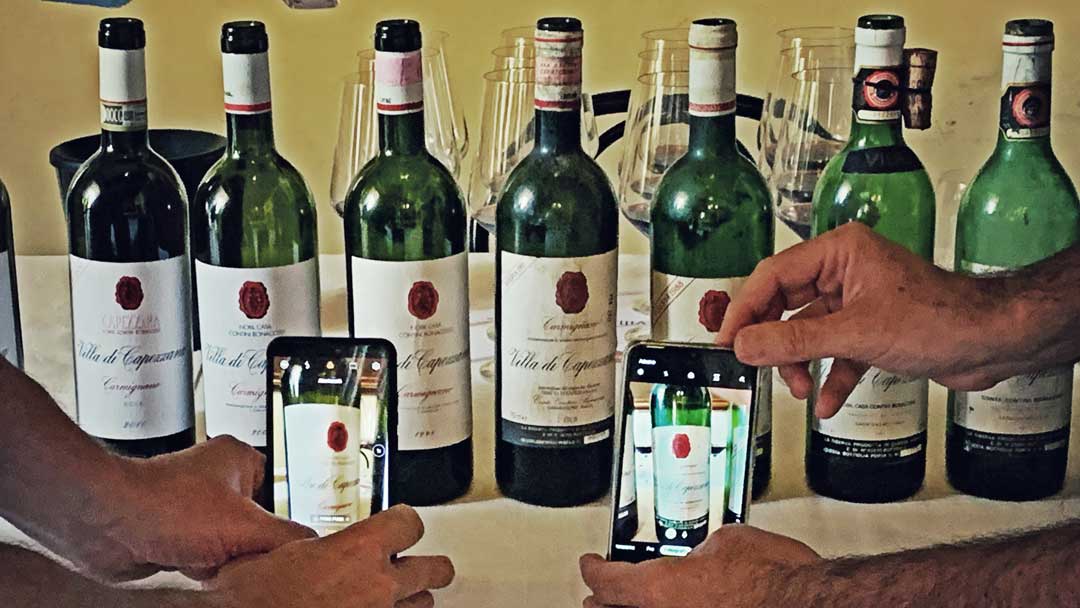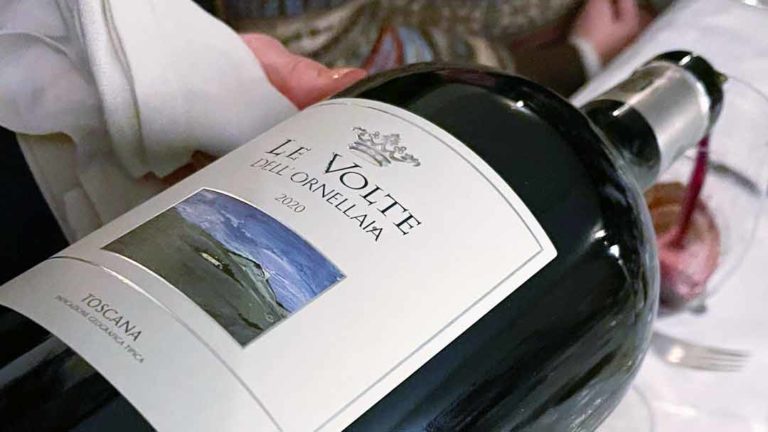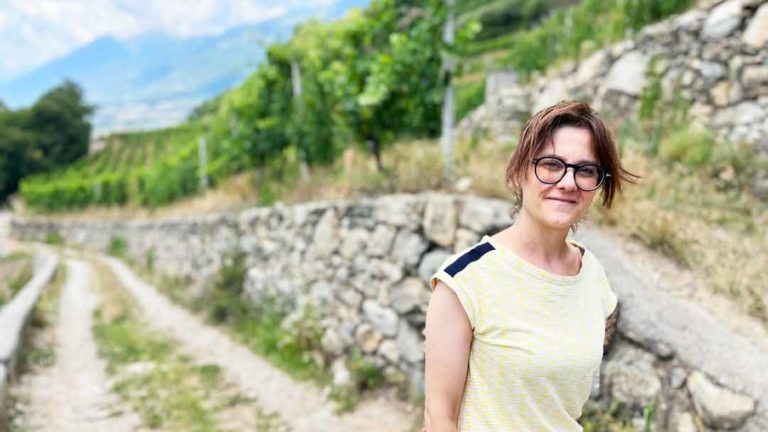Tuscan wines ageing with grace!
Few wineries manage to walk through history without following trends or markets, with the only aim to focus on quality. One of them is Capezzana in the unknown (to most) wine region of Carmignano in Tuscany. In September Capezzana organised a tasting with their flagship wine, Villa di Capezzana, made with 80 per cent sangiovese and 20 per cent of cabernet sauvignon. The first vintage was 1925, long before anyone had ever heard of the today famous Super Tuscans.
Sometimes it is quite a relief to taste a wine that is not made to be drunk young. Today, the wine market goes more and more towards fresh and fruity wines made to be drunk within a couple of years after harvest. In fact, most consumers drink their wines shortly after buying them. Very few bottles are put away to age for a longer time. But with Villa Capezzana you really should put away the bottles and forget them for quite some time. The younger vintages of Villa Capezzana are austere and not yet very approachable. This could be less attractive to those who don´t want to wait. But these wines are worth waiting for.
The tasting took place in the beautiful setting of the Villa Capezzana, where the noble family Contini Bonacossi, has their headquarters since 1920. If it weren’t for our modern clothes and face masks due to covid-19, we could have been in any period starting from 1474 when the Villa was built.
The first vintage of Villa Capezzana was 1925, and during this tasting, we had the opportunity to taste the 1930 vintage, fragile and lean but still alive. It is quite incredible to taste a wine that dates back before the Second World War and to compare it to vintages running up to the latest, 2017.
The property today is in the hands of the three siblings, Benedetta, Beatrice and Filippo, the fourth generation of the family, together with world-famous wine consultant Franco Bernabei.
Carmignano
Carmignano, 20 km west of Florence, is one of the most ancient wine regions in Tuscany but also one of the least known. A document from 1369 tells that the land in Carmignano at the time was four times more expensive than land in other areas. Here, sangiovese and canaiolo nero thrive in the lime-rich and free-draining soils. There is a significant temperature difference between night and day. The cool nights are due to the cold winds coming in from the Apennines while the days are warmed up by the Mediterranean sun. Also, international varieties, like cabernet sauvignon, are not new to the region. Cabernet was already planted in the 1700s since Carmignano was the home to many nurseries and cabernet sauvignon was brought in at the time from France. The region was awarded DOCG-status in 1990.
The climate is influenced by the nearby mountains that stop the sea winds and collect humidity. Nevertheless, Franco Bernabei says there is a particular saltiness in the wines from Carmignano due to the proximity to the sea. Rainfall is spread out throughout the year. It is not rare to have some rain even in July and August, something that helps to gain a balanced maturation.
Carmignano is a small region. In the 1990s there were only 100 hectares (220 acres). Today it has doubled. Small, but with exciting and age-worthy wines. If you have not yet tasted the wines from Carmignano, it is time to drop that glou glou-bottle and get moving.
Villa di Capezzana 2017 to 1930
Villa di Capezzana. 80% sangiovese and 20% cabernet sauvignon. Aged one year in French tonneaux.
Villa di Capezzana 2017
Medium ruby and pronounced aromas of inviting dense fruit, ripe red cherry, ripe raspberry, rose petals, lingonberry, leather, liquorice, hints of black pepper and earth. Harsh acidity, medium tannins with much grip, medium body, tight, dense. Still very young.
Villa di Capezzana 2016
Medium ruby, medium intensity, in the beginning closed but slowly opens up. Red cherry, raspberry, earthy and spicy, herbal, sage, mint, and rosemary, salty liquorice, but in a low-key way. Lean, medium elegant tannins, velvety, well-integrated acidity, iron kind of metallic, and long mouth-filling finish. Integrated elements and balanced.
Villa di Capezzana 2010
Medium ruby, medium intensity, red cherry, balsamic tones, coffee, black plum, cloves, juniper, liquorice, always something herbal, wild mint, beautiful medium plus velvety tannins, vivid integrated medium-plus acidity, coffee, balsamic, herbal, medium body, elegant, long elegant finish.
Villa di Capezzana 2006
Medium ruby, medium intensity, deep nose, tobacco, coffee, liquorice, dried plum, pine, bark, china bark, balsamic tones, dried wild mint, high metallic tannins stuck on the gums, medium acidity, dark, deep, very masculine.
Villa di Capezzana 1998
Medium garnet, jammy, plum, cherry marmalade, intense salty liquorice, rhubarb, dried tobacco, chocolate, balsamic tones, coffee beans, forest floor, wild fennel, mint, ripe fruit, broad, generous, velvety, elegant tannins, still fresh medium plus vivid acidity, vertical, well balanced
Villa di Capezzana 1995
Medium garnet, sweet spice, medium intensity, caraway, cardamom, cloves, liquorice, fennel, sage, china bark, cinnamon, black plum, ripe fruit, medium vivid tannins still with a grip, broad, elegant well-integrated medium lean acidity.
Villa di Capezzana 1988
Medium garnet, liquorice, leather, forest floor, calm, low key, very low fruit, not totally perfect, dry tannins, very spicy, lack of fruit and the acidity is not vivid, short finish.
Villa di Capezzana 1981
Pale garnet, dry plum, violet, currant, china bark, red pepper, coffee bean, rhubarb, balsamic, lean, still vivid acidity, silky, elegant tannins, tomato leaf, underbrush, slender and elegant, very clean, medium finish
Villa di Capezzana 1977
Pale garnet, medium intensity, rose petals, forest floor, dried plum, rhubarb, white pepper, coffee beans, balsamic, lean, soft, still incredibly well-kept fruit, silky tannins, medium vivid acidity, long elegant finish, crisp fruit and impressive wine.
Villa di Capezzana 1974
Medium intensity, sweet spice, tomato leaf, sage, thyme, meat, coffee beans, soya sauce, prune, carob, still grippy tannins medium, vivid medium-plus acidity, long finish full of carob and coffee beans
Villa di Capezzana 1969
(First DOC Carmignano and the first bottle sold to Enoteca Pinchiorri, today a 3-star Michelin restaurant in Florence with one of Europe’s biggest wine cellars.)
Pale garnet, sediments at the bottom at the glass. Dried lavender, mint, sage, thyme, coffee, balsamic vinegar, dry fruit, plum, dark, and deep, full taste, lean wine, broad and elegant, coffee and sage, balsamic, long dark finish full of coffee. Still rocking.
Villa di Capezzana 1930
(Less than a hundred bottles, hidden from the Germans during the Second World War.)
Pale garnet, sediments at the bottom of the glass, medium intensity dry fruit, rosehip, dry mint, dry plums, china bark, walnut, low shy tannins, still alive, still feel the fruit! Old and stylish, fragile and still beautiful.














